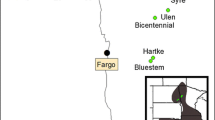Summary
The breeding systems of seven Limanthes (Limanthaceae) populations, including one “inbreeding” and three “outbreeding” taxa, were quantified using a multilocus outcrossing rate estimator (tm) and autofertility estimates. Along with the assays of heterozygosity levels, these data were used to separate components of “effective” outcrossing in terms of Wright's equilibrium inbreeding coefficient (Fe) and adult (FA) and zygotic (FZ) fixation indices. The patchy distribution of alleles as a potential source of “substructure inbreeding” was tested from the allelic frequencies mapped along a linear transect. Evidence for consanguineous matings in restricted neighborhoods and for selection at two different life cycle stages, and the efficiency of the protandrous breeding system were noted and discussed. Multilocus estimates of outcrossing are useful for their greater precision and unbiased nature while single locus estimates can help in detecting the effects of selection and population substructure. The data generally support the “heterozygosity paradox” noted by Brown (1979) but further suggest that the paradox may often result from a lack of precision of outcrossing estimates and from overlooking the stages of the life cycle being sampled.
Similar content being viewed by others
References
Allard RW (1975) The mating system and microevolution. Genetics 79:115–126
Allard RW, Kahler AL, Clegg MT (1977) Estimation of the mating cycling components of selection in plants. In: Christiansen FB, Frenchel TM (eds) Measuring selection in natural populations. Springer, Berlin Heidelberg New York, pp 1–19
Allard RW, Workman PL (1963) Population studies in predominantly self-pollinated species. 4. Seasonal fluctuations in estimated values of genetic parameters in lima ben populations. Evolution 17:470–480
Antonovics J, Ellstrand NC (1984) Experimental studies of the evolutionary significance of sexual reproduction. 1. A test of the frequency-dependent selection hypothesis. Evolution 38:103–115
Brown AHD (1979) Enzyme polymorphism in plant populations. Theor Popul Biol 15:1–42
Brown AHD, Zohary D, Nevo E (1978) Outcrossing rates and heterozygosity in natural populations of Hordeum spontaneum Koch in Israel. Heredity 41:49–62
Clegg MT (1980) Measuring plant mating systems. Bioscience 30:814–818
Ellstrand NC, Torres AM, Levin DA (1978) Density and the rate of apparent outcrossing in Helianthus annuus (Asteraceae). Syst Bot 3:403–407
Ennos RA, Clegg MT (1982) Effect of population substructuring on estimates of outcrossing rate in plant populations. Heredity 48:283–292
Hamrick JL (1982) Plant population genetics and evolution. Am J Bot 69:1685–1693
Harding J, Mankinen CB, Elliot MH (1974) Genetics of Lupinus. 7. Outcrossing autofertility and variability in natural populations of the nanus group. Taxon 23:729–738
Hedrick P, Jain S, Holden L (1978) Multilocus systems in evolution. Evol Biol 11:101–184
Jain SK (1975) Population structure and the effects of breeding systems. In: Frankel OH, Hawkes JG (eds) Crop genetic resources for today and tomorrow. Cambridge University Press, London, pp 15–36
Jain SK (1976) The evolution of inbreeding. Ann Rev Ecol Syst 7:469–496
Kesseli RV, Jain SK (1984a) New variation and biosystematic pattern detected by allozyme and morphological comparisons in Limnanthes section Reflexae (Limnanthaesae). Plant Syst & Evol 147:133–165
Kesseli RV, Jain SK (1984b) An ecological genetic study of gynodioecy in Limnanthes douglasii. Am J Bot 71: 775–786
Kesseli RV, Jain SK, Thorpe R (in preparation) Patterns of gene flow and inbreeding in genus Limnanthes
Lerner IM (1954) Genetic homeostasis. Oliver and Boyd, London
Mason CT Jr. (1952) A systematic study of the genus Limnanthes R. Br. Univ Calif Publ Bot 25:455–512
McNeill CI, Jain SK (1983) Genetic differentiation and phylogenetic inference in the plant genus Limnanthes L. Section Inflexae. Theor Appl Genet 66:257–269
Moran GF, Brown AHD (1980) Temporal heterogeneity of outcrossing rates in alpine ash (Eucalyptus elegans R. T. Bak). Theor Appl Genet 57:101–105
Mulcahy DL, Mulcahy GB (1983) Gametophytic self-incompatibility reexamined. Science 220:1247–1251
Ornduff R, Crovello TJ (1968) Numerical taxonomy of Limnanthaceae. Am J Bot 55:173–182
Phillips MA, Brown AHD (1977) Mating systems and hybridity in Eucalyptus pauciflora. Aust J Biol Sci 30: 337–344
Pielou EC (1974) Population and community ecology. Principles and methods. Gordon and Breach, New York
Rick CM, Fobes JF, Halle M (1977) Genetic variation in Lycopersicon pimpinellifolium: evidence of evolutionary change in mating systems. Plant Syst Evol 127:139–170
Ritland KR (1984) The effective proportion of self-fertilization with consanguineous matings in inbred populations. Genetics 106:139–152
Ritland KM, Jain SK (1981) A model for the estimation of outcrossing rate and gene frequencies using N independent loci. Heredity 46:35–52
Sanders T, Hamrick JL (1980) Variation in the breeding system of Elymus canadensis. Evolution 34:117–122
Shaw DV, Allard RW (1981a) Analyses of mating system parameters and population structure in Douglas Fir using single and multilocus methods. In: Isozymes of forest trees and forest insects. Techn Rep PSW-48, Berkeley, pp 18–22
Shaw DV, Kahler AL, Allard RW (1981b) A multilocus estimator of mating system parameters in plant populations. Proc Natl Acad Sci USA 78:1298–1302
Wright S (1965) The interpretation of population structure by F-statistics with special regard to systems of mating. Evolution 19:395–420
Author information
Authors and Affiliations
Additional information
Communicated by P. M. A. Tigerstedt
Rights and permissions
About this article
Cite this article
Kesseli, R.V., Jain, S.K. Breeding systems and population structure in Limnanthes . Theoret. Appl. Genetics 71, 292–299 (1985). https://doi.org/10.1007/BF00252070
Accepted:
Issue Date:
DOI: https://doi.org/10.1007/BF00252070




